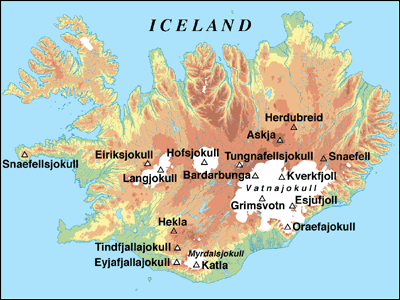Western Europe & North Atlantic: Regional Map and Introduction
 Select a mountain from the clickable maps above or below  Iceland base map courtesy of National Land Survey of Iceland <Click here to view an enlarged version> |
|
The Mid-Atlantic Ridge .
Most of the volcanoes of Europe actually lie hundreds of miles out to sea along the Mid-Atlantic Ridge, an undersea spreading center where the North American and Eurasian Plates are moving apart at the rate of a few inches per year. Vast quantities of basalt are erupted to continually fill in the ever-widening gap. Numerous volcanoes along the ridge have built up high enough to break the surface as islands, a rise of over 10000 ft (3000 m) from the seafloor. The northernmost of these is the island of Jan Mayen, which lies above the Arctic Circle and is home to the spectacular stratovolcano Beerenberg. Next in line to the south is Iceland, which is by far the largest volcanic island in the world and home to hundreds of volcanoes of every type which have formed the island over the past 20 million years. A few dozen of them are still active, and there are typically several eruptions in Iceland each decade. Iceland has many more skiable volcanoes than the entire rest of Europe combined. The country is nearly treeless and there are vast stretches of barren terrain, intersprersed with numerous chasms and mountains and glaciers. Four huge icefields crown the island, Langjokull, Hofsjokull, Myrdalsjokull, and Vatnajokull, each built upon one or more large subglacial volcanoes. Vatnajokull is the the largest icefield in Europe, and under it lie at least four major volcanoes, Bardarbunga, Grimsvotn, Kverkfjoll, and Esjufjoll, with the largest single volcano in Iceland, Oraefajokull, adjoining it to the south. Multiday ski traverses across the major icefields are quite commonly done. Many of Iceland's volcanoes are popular and accessible, with excellent terrain for ski mountaineering on the roadside stratovolcanoes such as Snaefellsjokull and Eyjafjallajokull and even on the frequently active Hekla. However, the often stormy weather can make skiing and climbing conditions quite challenging in any part of the country, even during the spring and summer. Much farther south in a more temperate climate are the Azores, a group of nine volcanic islands straddling the Mid-Atlantic Ridge about 1000 miles (1600 km) west of Portugal. There are many interesting volcanoes here, especially the numerous calderas, but the most singular and striking feature is the majestic stratovolcano of Pico, which is often snowcapped during the winter months. This is the only one of the major Azores stratovolcanoes which has not undergone a caldera collapse, and thus it reaches more than twice the height of any other peak in the islands. The Mediterranean . Europe's second major volcanic area is among the most famous in the world, an irregular band of volcanoes across southern Italy and Greece where the Eurasian and African Plates meet. In contrast to the spreading along the Mid-Atlantic Ridge, here the plates are converging in a complex subduction zone as the African Plate tries to sink beneath the Eurasian, fracturing into a number of small microplates which divide the volcanism into separate smaller regions. Although there are many volcanoes to be found in the Mediterranean, most are very modest in height and only Sicily's massive Mount Etna reaches above even 5000 ft (1500 m). The hot and arid climate combined with this overall lack of elevation limits the good ski possibilities to the snowcapped Etna, which is a very fine ski mountain when not erupting as it frequently is. Perhaps also skiable is the famed cone of Vesuvius, which does receive modest winter snowfalls. Farther north in central Europe, the collision between the Eurasian and African Plates has caused the upthrust of the huge mountain mass of the Alps, which stretches from France into Italy and Switzerland and continues on towards eastern Europe. The undiputed monarch of the range is Mont Blanc, which towers above all other peaks in western Europe. The only volcanoes in this area are in the Massif Central of France, which has a wide range of volcanic landforms including a pair of old eroded stratovolcanoes, Mont Dore and Monts du Cantal, and a large volcanic field of lava domes and cinder cones, the Chaine des Puys. The geologic origin of these volcanoes is still an open question, but they are believed to be caused by tension cracking of the crust due to the weight of the nearby Alps, which allows magma to leak upwards. The climate here is much colder and wetter, and the snowfall is sufficient to support several ski areas on these volcanoes. |
|